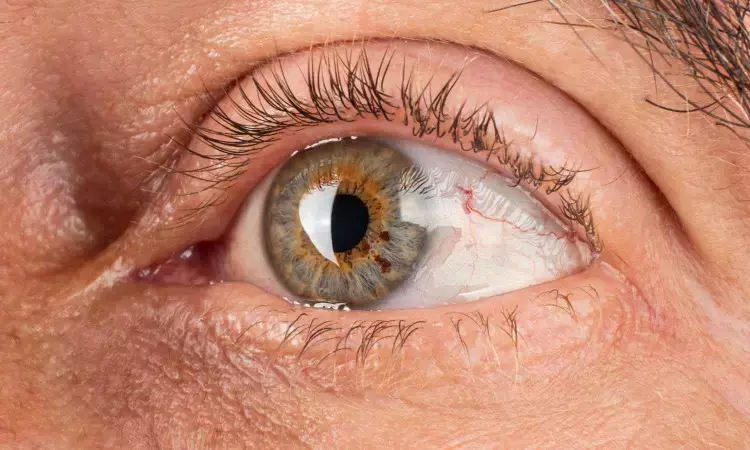- Home
- Medical news & Guidelines
- Anesthesiology
- Cardiology and CTVS
- Critical Care
- Dentistry
- Dermatology
- Diabetes and Endocrinology
- ENT
- Gastroenterology
- Medicine
- Nephrology
- Neurology
- Obstretics-Gynaecology
- Oncology
- Ophthalmology
- Orthopaedics
- Pediatrics-Neonatology
- Psychiatry
- Pulmonology
- Radiology
- Surgery
- Urology
- Laboratory Medicine
- Diet
- Nursing
- Paramedical
- Physiotherapy
- Health news
- Fact Check
- Bone Health Fact Check
- Brain Health Fact Check
- Cancer Related Fact Check
- Child Care Fact Check
- Dental and oral health fact check
- Diabetes and metabolic health fact check
- Diet and Nutrition Fact Check
- Eye and ENT Care Fact Check
- Fitness fact check
- Gut health fact check
- Heart health fact check
- Kidney health fact check
- Medical education fact check
- Men's health fact check
- Respiratory fact check
- Skin and hair care fact check
- Vaccine and Immunization fact check
- Women's health fact check
- AYUSH
- State News
- Andaman and Nicobar Islands
- Andhra Pradesh
- Arunachal Pradesh
- Assam
- Bihar
- Chandigarh
- Chattisgarh
- Dadra and Nagar Haveli
- Daman and Diu
- Delhi
- Goa
- Gujarat
- Haryana
- Himachal Pradesh
- Jammu & Kashmir
- Jharkhand
- Karnataka
- Kerala
- Ladakh
- Lakshadweep
- Madhya Pradesh
- Maharashtra
- Manipur
- Meghalaya
- Mizoram
- Nagaland
- Odisha
- Puducherry
- Punjab
- Rajasthan
- Sikkim
- Tamil Nadu
- Telangana
- Tripura
- Uttar Pradesh
- Uttrakhand
- West Bengal
- Medical Education
- Industry
Age-related Eye Diseases Increase Risk of Comorbid CHD and Depression, reveals study

Researchers have discovered in a new study that patients with age-related eye diseases (AREDs) have a significantly increased risk of simultaneously developing coronary heart disease (CHD) and depression as compared to either of the conditions alone. The research established that patients with AREDs, such as age-related macular degeneration, glaucoma, cataract, and diabetes-related eye diseases (DRED), need to undergo extensive screening for CHD and depression comorbidity as a component of chronic disease care. The study was published in the journal of Psychology Research and Behavior Management by He X. and colleagues.
The study was performed using UK Biobank data, with baseline measurements taken between March 2006 and December 2010, and follow-up to July 2021. There were 116,501 participants who were CHD- and depression-free at baseline. During a median follow-up of 11.82 years (interquartile range: 11.51–13.11), investigators examined the incidence of CHD, depression, and comorbidity. Incident cases were established through hospitalization data and self-reporting. Multivariable Cox proportional hazard regression analyses were used to evaluate the risk association of AREDs with health events.
Results
During the study duration, 7,750 (6.65%) developed CHD, 3,682 (3.16%) developed depression, and 741 (0.64%) developed both comorbidities together.
After controlling for confounding variables, people with AREDs had a 10% higher risk of developing CHD (hazard ratio [HR] 1.10, 95% CI: 1.03–1.17), a 28% higher risk of developing depression (HR 1.28, 95% CI: 1.16–1.42), and a 37% higher risk of developing both conditions as comorbidity (HR 1.37, 95% CI: 1.12–1.67).
Subsequent analysis revealed that those with cataract were specifically at risk, having a 57% increased hazard of comorbidity (HR 1.57, 95% CI: 1.23–2.03) and a 26% increased hazard of depression (HR 1.26, 95% CI: 1.10–1.43).
Additionally, diabetic eye diseases were found to have an increased hazard of 33% for new CHD (HR 1.33, 95% CI: 1.13–1.56).
These results suggest that not all AREDs are equally associated, but as a whole, their presence enhances susceptibility to both cardiovascular and mental disorders.
This research proved that ARED individuals were more likely to co-develop CHD and depression simultaneously than either condition individually. Cataract was highly related to comorbidity and depression, whereas DRED was highly related to CHD risk. These results emphasize the necessity of employing multidisciplinary methods in treating patients with ARED and underscore the significance of early screening and prevention in minimizing long-term disease burden.
Reference:
He, X., Li, C., Wang, Y., Du, Z., Jiang, J., Zhang, W., … Yang, X. (2025). Association of Age-Related Eye Diseases with Comorbidity of Coronary Heart Disease and Depression in a Population-Based Cohort Study. Psychology Research and Behavior Management, 18, 1931–1942. https://doi.org/10.2147/PRBM.S533879
Dr Riya Dave has completed dentistry from Gujarat University in 2022. She is a dentist and accomplished medical and scientific writer known for her commitment to bridging the gap between clinical expertise and accessible healthcare information. She has been actively involved in writing blogs related to health and wellness.
Dr Kamal Kant Kohli-MBBS, DTCD- a chest specialist with more than 30 years of practice and a flair for writing clinical articles, Dr Kamal Kant Kohli joined Medical Dialogues as a Chief Editor of Medical News. Besides writing articles, as an editor, he proofreads and verifies all the medical content published on Medical Dialogues including those coming from journals, studies,medical conferences,guidelines etc. Email: drkohli@medicaldialogues.in. Contact no. 011-43720751


